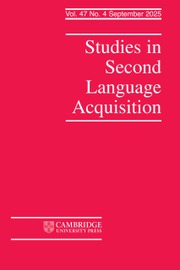Article contents
The interplay of learners’ cognitive abilities in the learning and automatization of miniature language grammar
What matters beyond general IQ?
Published online by Cambridge University Press: 28 March 2025
Abstract
This study focused on the relative contributions of cognitive aptitudes to the incidental learning and automatization of mini-language grammar. Over three sessions, participants (N = 45; first language [L1] Polish; age range: 19–35) completed computerized training in MiniItaliano as well as tasks tapping into working memory, general intelligence, and language analytic ability (LAA). The overt aim of the training was to comprehend messages placed in the context of an Italian supermarket; however, its actual goal was to acquire the target syntactic rules (i.e., subject-verb agreement, gender agreement, word order). The final session included a surprise post-test with untimed and timed grammaticality judgment tasks (GJTs) as measures of explicit and automatized knowledge, respectively. Results showed that performance on both tasks was predicted by LAA over and above other cognitive and control measures. Additionally, scores on the untimed GJTs were related to reliance on (self-discovered) rules, while timed GJTs involved general IQ.
Keywords
Information
- Type
- Research Article
- Information
- Open Practices
Open data
- Copyright
- © The Author(s), 2025. Published by Cambridge University Press
References
- 1
- Cited by


